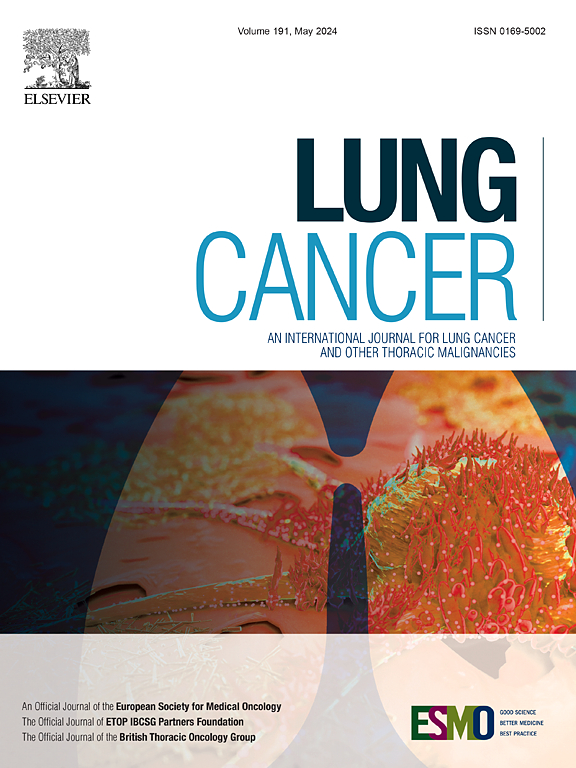Discovery of actionable drug targets to enhance T-cell infiltration and immune checkpoint blockade efficacy in pleural mesothelioma
IF 4.4
2区 医学
Q1 ONCOLOGY
引用次数: 0
Abstract
Background
Malignant pleural mesothelioma (PM) is an aggressive cancer with limited treatment options. Although first-line nivolumab plus ipilimumab improves outcomes for some patients, a majority fail to respond. Mechanisms of immune resistance in PM remain poorly understood, underscoring the need for new clinically actionable drug targets to overcome immunotherapy resistance.
Methods
We established an in silico pipeline to investigate the molecular basis of T-cell exclusion in bulk RNA-sequencing data from 448 patients across three immune checkpoint blockade (ICB)-naïve PM cohorts. We assessed genome-wide correlations between gene expression and a previously validated cytotoxic T-cell signature score. Candidate immune evasion genes were prioritized based on clinical relevance, drug availability, and experimental feasibility for follow-up translational research.
Results
The in silico pipeline produced a highly reproducible catalogue of genes whose expression inversely correlates with T-cell infiltration, including established immune evasion factors (e.g. SOX4, KDM5B, CMTM4) and five novel FDA-approved drug targets (SMO, GANAB, ERBB2, GABRA1, ODC1). Seven additional targets (ARNT, BMPR1B, GSK3B, ACVR1, BACE1, RPS6KB1, ULK1) with preclinical inhibitors were also identified. Notably, we identified a possible link between primary cilia, Hedgehog signaling and T-cell exclusion. We found that SMO expression correlated with poor clinical response to second-line nivolumab plus ipilimumab in PM, highlighting SMO as a promising therapeutic target and potential biomarker for treatment resistance.
Conclusions
This comprehensive transcriptomic characterization of T-cell exclusion in PM reveals that targeting cilium-based Hedgehog signaling, in addition to multiple other actionable drug targets, could enhance the efficacy of ICB treatment in PM.
增强胸膜间皮瘤t细胞浸润和免疫检查点阻断疗效的有效药物靶点的发现
恶性胸膜间皮瘤(PM)是一种侵袭性癌症,治疗选择有限。虽然一线nivolumab联合ipilimumab改善了一些患者的预后,但大多数患者没有反应。PM的免疫耐药机制仍然知之甚少,强调需要新的临床可操作的药物靶点来克服免疫治疗耐药。方法我们建立了一个计算机流水线来研究来自三个免疫检查点阻断(ICB)-naïve PM队列的448例患者的大量rna测序数据中t细胞排斥的分子基础。我们评估了基因表达与先前验证的细胞毒性t细胞特征评分之间的全基因组相关性。候选免疫逃避基因根据临床相关性、药物可用性和后续转化研究的实验可行性进行优先排序。结果通过计算机流水线,获得了表达与t细胞浸润呈负相关的高重复性基因目录,包括已建立的免疫逃避因子(如SOX4、KDM5B、CMTM4)和5个fda批准的新药物靶点(SMO、GANAB、ERBB2、GABRA1、ODC1)。另外还发现了7个具有临床前抑制剂的靶点(ARNT、BMPR1B、GSK3B、ACVR1、BACE1、RPS6KB1、ULK1)。值得注意的是,我们发现了初级纤毛、Hedgehog信号和t细胞排斥之间的可能联系。我们发现SMO表达与二线nivolumab + ipilimumab在PM中的不良临床反应相关,强调SMO是一个有希望的治疗靶点和治疗耐药的潜在生物标志物。结论对PM中t细胞排斥的综合转录组学表征表明,除了多种其他可操作的药物靶点外,靶向基于纤毛的Hedgehog信号通路可以增强ICB治疗PM的疗效。
本文章由计算机程序翻译,如有差异,请以英文原文为准。
求助全文
约1分钟内获得全文
求助全文
来源期刊

Lung Cancer
医学-呼吸系统
CiteScore
9.40
自引率
3.80%
发文量
407
审稿时长
25 days
期刊介绍:
Lung Cancer is an international publication covering the clinical, translational and basic science of malignancies of the lung and chest region.Original research articles, early reports, review articles, editorials and correspondence covering the prevention, epidemiology and etiology, basic biology, pathology, clinical assessment, surgery, chemotherapy, radiotherapy, combined treatment modalities, other treatment modalities and outcomes of lung cancer are welcome.
 求助内容:
求助内容: 应助结果提醒方式:
应助结果提醒方式:


